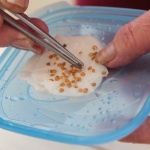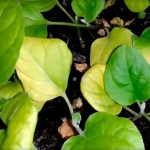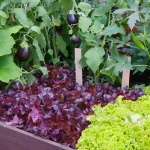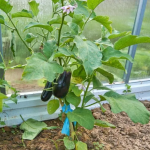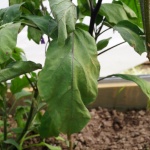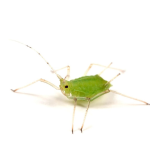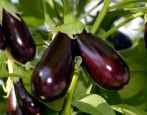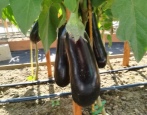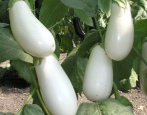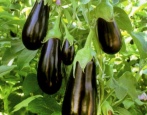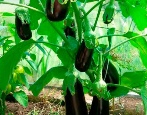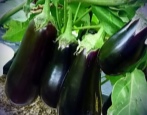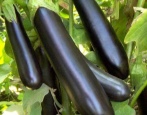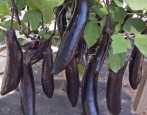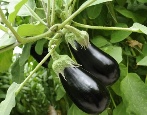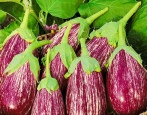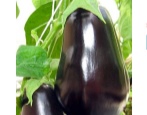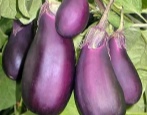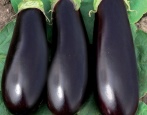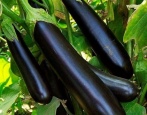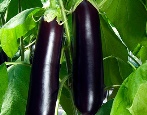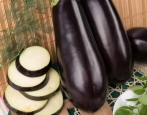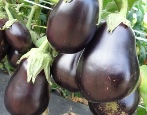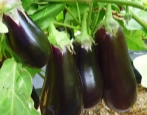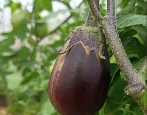
- Authors: Nastenko N.V., Kachainik V.G., Gulkin M.N.
- Year of approval: 2008
- Growth type: medium-sized
- Bush height, cm: up to 120
- Fruit shape: pear-shaped
- Fruit weight, g: 250
- Yield: high yielding
- Fruit color: dark purple
- Keeping quality: good
- Transportability: good
Due to the huge variety of eggplant varieties, every vegetable grower or farmer can choose the most productive and non-capricious variety for growing. For growing in beds, under film and in greenhouses, the early ripe Mishutka eggplant, created by Russian breeders, is ideal.
Breeding history
The Mishutka variety is the result of the work of the scientists of the Aelita agricultural company, who created a vegetable crop in 2007. The authorship belongs to the breeders Nastenko N.V., Gulkin M.N. and Kachainik V.G.
The vegetable appeared in the State Register of Approved for Use in 2008. The variety is zoned for all climatic zones of Russia. You can cultivate a vegetable under film shelters, in greenhouses, greenhouses, in garden beds.
Description of the variety
The bear is a medium-sized plant that can stretch up to 70-120 cm in height. The eggplant shrub is characterized by semi-spreading branches, good foliage, large, bright green leaves, a powerful central trunk without anthocyanin and a strong root system. It is worth noting the weak pubescence of the stem, as well as the absence of thorns on the calyx.
A distinctive feature of the plant is the formation of 2-3 fruits on one cluster. This is the reason for the high yield of the variety. As a rule, 7-8 even and neat fruits ripen on one bush. Outwardly, the bushes with fruits look very attractive, since the eggplants hang down in clusters drooping.
Characteristics of the appearance of plants and fruits
Eggplant Mishutka is endowed with an attractive presentation. Fruits of the same shape and length ripen. The average weight of a vegetable with a length of 20-25 cm is 200-250 grams. The shape of the vegetable is standard - pear-shaped with a rounded ending. The color of the unripe fruit is pale burgundy, and the fully ripe eggplant has a uniform dark purple color that appears almost black. The peel of the vegetables is loose, but very firm. The surface of the eggplant is smooth, shiny, without bulges.
Ripe vegetables can be transported long distances and stored in a cool place for a long time. Neatly cut eggplants lie in a dry and cold room for several months without loss of marketability and taste.
Purpose and taste
Mishutka is remembered for its excellent taste. The white-yellowish flesh has a dense, fleshy, tender flesh without wateriness and fibrillation. The taste of the vegetable is pleasant, delicate, without bitterness and astringency. The good news is that there is a minimum content of medium-sized seeds in the pulp.
The variety is famous for its wide range of applications in cooking - vegetables are fried, stewed, baked, frozen, and also pickled and canned.
Ripening terms
Teddy bear is an early ripening variety. The growing season lasts about 4 months - 100-115 days. The advantage of the culture is prolonged fruiting, which allows you to enjoy fresh eggplants for a long time. The massive harvest takes place in July-August. In regions with warm and long summers, you can remove fresh vegetables from the bushes before the autumn cold.
Yield
The variety is declared as high-yielding, which captivates many vegetable growers. Taking good care of the bushes, you can collect about 8-9 kg of fleshy fruits from 1 m2 of plantings. On garden ridges, the yield is slightly lower - up to 6-7 kg / m2.
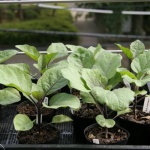
To get a tasty and bountiful eggplant crop, you must first grow strong and healthy seedlings. This culture is considered very capricious, therefore, you need to take care of seedlings when growing at home as correctly and carefully as possible.
Landing scheme
When planting a vegetable, it is important to observe the planting density, as well as the correct distance between the bushes. As a rule, there are up to 4-5 eggplant bushes per 1 m2. Plants are planted according to the standard scheme 60x40 cm.
Growing and care
The culture is most often grown in a seedling method, which guarantees earlier ripening periods and high yield rates. As planting material, strong bushes are selected at the age of 60-70 days with 5-8 true leaves and a formed root system. Planting in a greenhouse or open ground is carried out from May 20 to June 10. The best predecessors for vegetable crops are pumpkin, onions, and legumes.
The plant does not need intensive agricultural technology, but the basic recommendations should be followed - watering with warm / settled water every 10-15 days, applying dressings 3 times per season, alternating mineral and organic complexes, weeding and loosening the soil, forming and tying bushes to supports, removing extra side shoots, leaving up to 5 shoots, prevention of diseases and insect infestations.
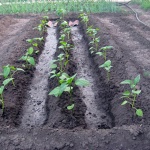
Planting eggplant is one of the most important stages in growing. When choosing a place for eggplants on your site, it is important to remember that this culture should be in warm soil, constantly illuminated by the sun. The plant is also very fond of spacious, open spaces, since its roots can grow over sufficient areas.
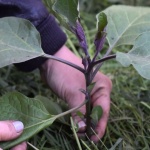
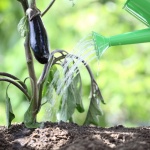
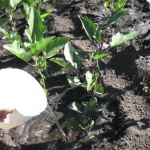
Soil requirements
The structure of the soil does not really matter - the main thing is that it is light, fertile, moisture and air permeable. Planting in acidic and waterlogged soils is not recommended.
Required climatic conditions
Eggplant grows comfortably in sunny areas, with plenty of light and warmth, and protection from gusty winds.
Disease and pest resistance
The Mishutka variety is rarely affected by fungal and viral diseases, if the irrigation regime on the ridges and the regularity of airing in greenhouse structures are observed.

Eggplant is one of the most demanding crops. For its successful cultivation, it is necessary to create optimal conditions, as well as to carry out prevention and fight against diseases and pests. Eggplant often infects both fungal and viral diseases.If treatment is not started on time, you can completely lose the crop.
